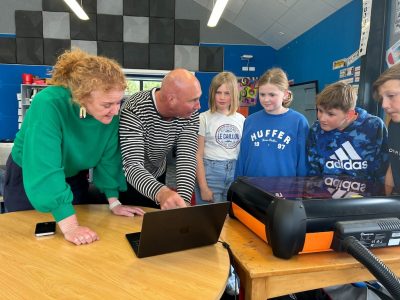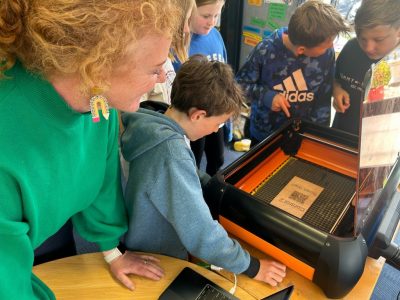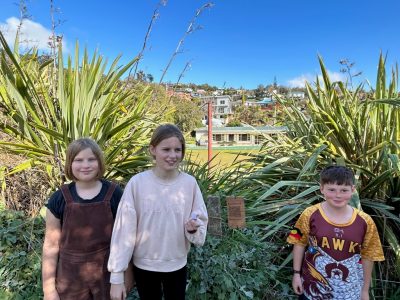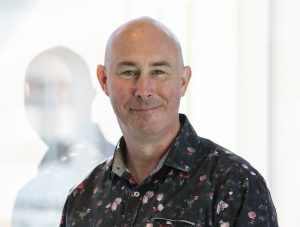Scenario
Primarily designed to raise teacher capability across Macandrew Bay School, this local curriculum/digital fluency project-based learning programme centres on design-thinking with a technology focus.
Approaching the project through the lens of Manaakitanga, (the school’s theme for 2023) the team were keen to explore the learning in a local context, in a way that would demonstrate how they are caring for their local environment and community.

Knowing where to start is often the biggest hurdle when tackling a school-wide initiative working with unfamiliar tools and tech, so Iain was involved from the outset. Helping the team assess the needs and pinpoint their focus in the staff planning meeting, he was able to help them map the way forward. As part of the project kick-off, Iain led a meeting with teaching staff to look at possible options. One project they chose to focus on was designing a local Orienteering track that borders the school grounds, (and was created by a student’s family) Iain and the team went on to explore the digital technologies strands and how they might be incorporated to enhance and promote this project.
The team is aware that community partnerships can add really valuable depth to learning, giving students an opportunity to work in authentic contexts with a real world client, having real conversations. Although new to working with community stakeholders, the school is a community school and with relationships always having been a priority, they were keen to look at how they could further enhance and build effective relationships and partnerships.
Having already worked with the school as part of the Coastal Otago STEAM cluster, Dunedin-based Iain is familiar with both its location and its local community, so was able to tap into relevant local contacts for them from previous projects he’s been involved with.
Solution
Iain took a design-thinking approach with staff consultation and planning, and a hands-on, modelling approach in the classroom with students. This was via a mixture of groups and one-on-one teacher development to provide deeper understanding of tools.
As the project progressed, he helped guide the discussion in further staff meetings to reflect on what the learning actually looked like in local curriculum terms.
 Introducing the teachers and students to 3-D modelling was one of the first steps, with Iain working alongside teachers and students to show them how to model local wildlife and points of local interest, creating a digital Piwakawaka using TinkerCad.
Introducing the teachers and students to 3-D modelling was one of the first steps, with Iain working alongside teachers and students to show them how to model local wildlife and points of local interest, creating a digital Piwakawaka using TinkerCad.
This not only involved the modelling, but was broken down into creating, publishing and presenting AR/QR codes which could/can be used in many different ways, depending on the outcomes they are looking for. They also learnt how to use TinkerCad for designing 3D models to illustrate different parts of the story they were bringing to life.
Additionally, Iain taught one of the team how to use a laser cutter to create signage for the orienteering track.
The Orienteering project has now been completed and installed, although at this stage, the official launch is still to happen. The project includes interactive presentations via QR Code which are ready for the public to use. The next steps as part of the launch are to invite the community in, request feedback from the community and stakeholders, and celebrate the outcome.
A key part of the process was being able to identify features of the overall teaching and learning approach and then from there, identifying suitable digital tools to support the overall goals, followed up with in-class learning.
Results
Building on previous PLD in design thinking and STEAM, the school can now consolidate this into a personalised learning framework; this is building the kete for teachers and students.
 Iain taught some of the senior school team and students to make the digital Piwakawaka, with the idea being that they in turn can now work with fellow colleagues and classmates, teaching them how to approach the modelling/QR Code process; they can then use these tools for exploring Science and the Living World, looking at other creatures, plants, trees or whatever else of significance they might be studying.
Iain taught some of the senior school team and students to make the digital Piwakawaka, with the idea being that they in turn can now work with fellow colleagues and classmates, teaching them how to approach the modelling/QR Code process; they can then use these tools for exploring Science and the Living World, looking at other creatures, plants, trees or whatever else of significance they might be studying.
Everyone was onboard with the project. Along the way, the Leadership team has encouraged staff and student voice in choosing how they have engaged with, and differentiated the project across Yr 1- Yr 6 levels. For example, Year 1 learnt about movie making and creating animated stories using computational thinking, and senior students explored how to create presentations with Canva as an alternative to Google Slides.
The team did encounter a few challenges with this project, for example, moving Yrs 3-4 from 2D to 3D thinking can be quite tricky. Students and teachers took some time to get used to looking at their models from different viewpoints, but they overcame this through trial and error, learning that when it comes to geometry, practice makes perfect.
It was initially quite challenging for some staff to get to grips with a deeper understanding of computational thinking (CT). This involved staff learning new jargon, getting to grips with what computational thinking actually is (deconstructing and decomposing problems), and how it can be taught in the classroom. This included transferring their growing knowledge of CT into the physical world, for example: pattern recognition (trends & patterns, replication)
As a result of this project, staff and students have improved key competencies, especially Managing Self: by persevering with a large problem, and breaking it down into smaller parts.
Future
All these investigations can be undertaken by the students and used to capture and tell local stories, using the same questions and approach as for the Orienteering track. They have ideas for the Marine Centre, Glenfalloch Gardens, Bike Skills track, being kaitiaki for the Otago Peninsula cycleway and a local Wildlife Tour, to help teach about local wildlife.
The staff and students at Macandrew Bay School are really looking forward to celebrating their learning with the community.

Contact: Iain Cook-Bonney, [email protected]


